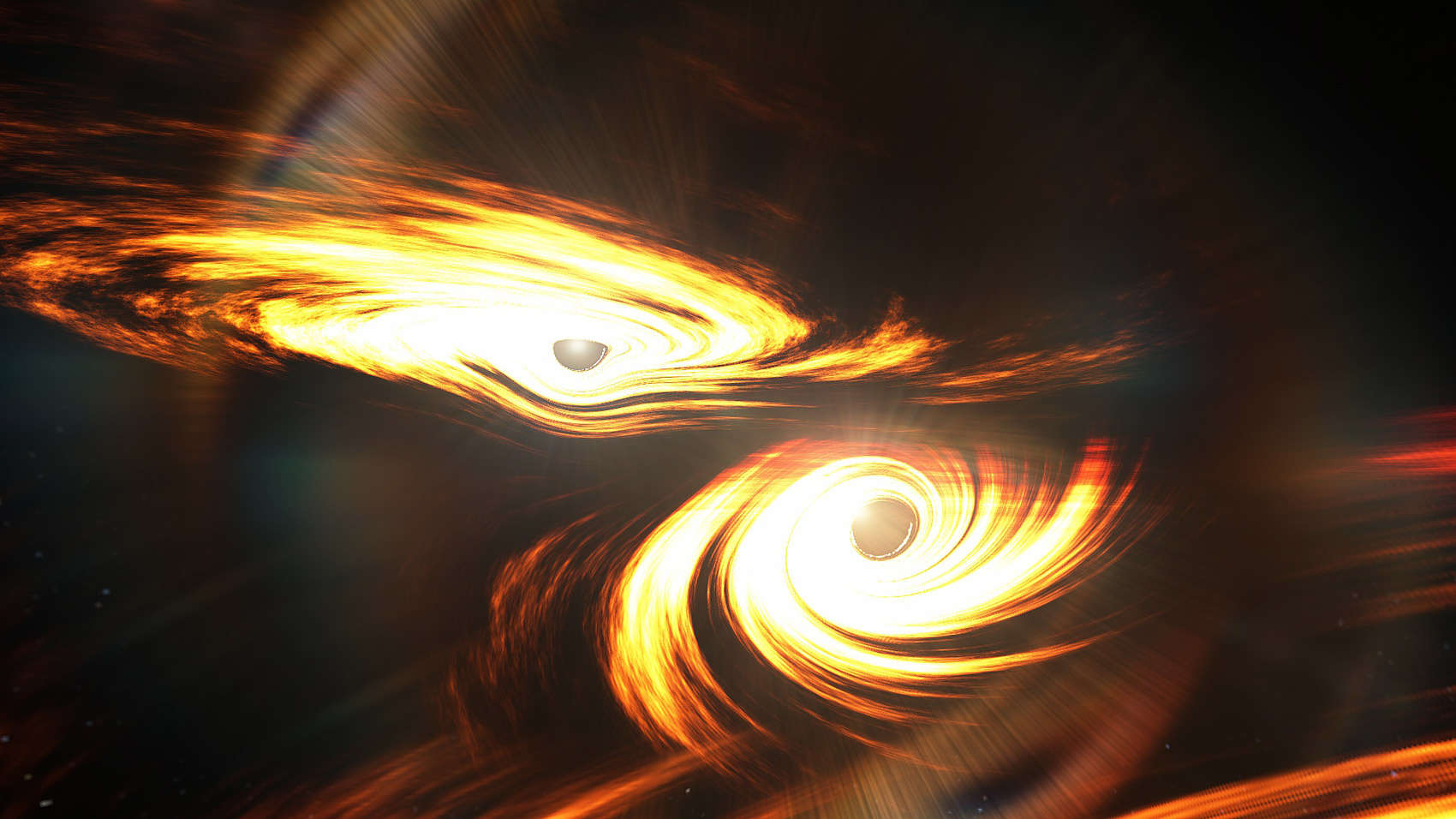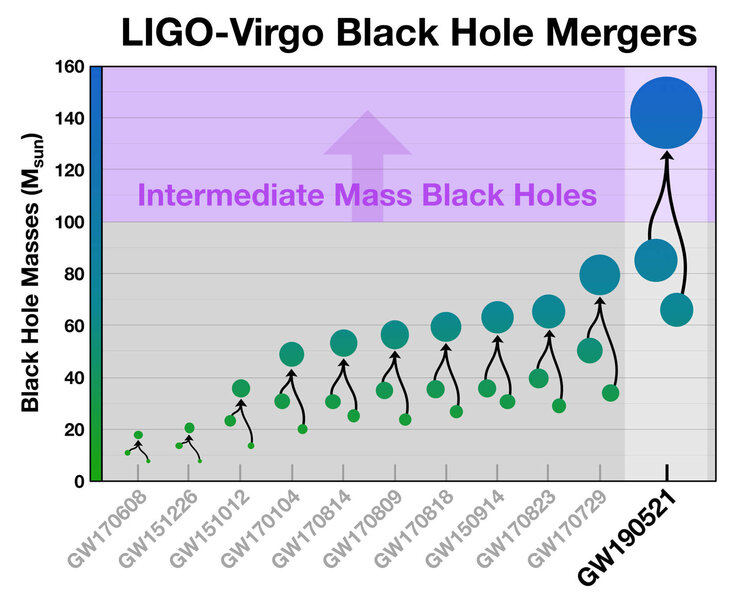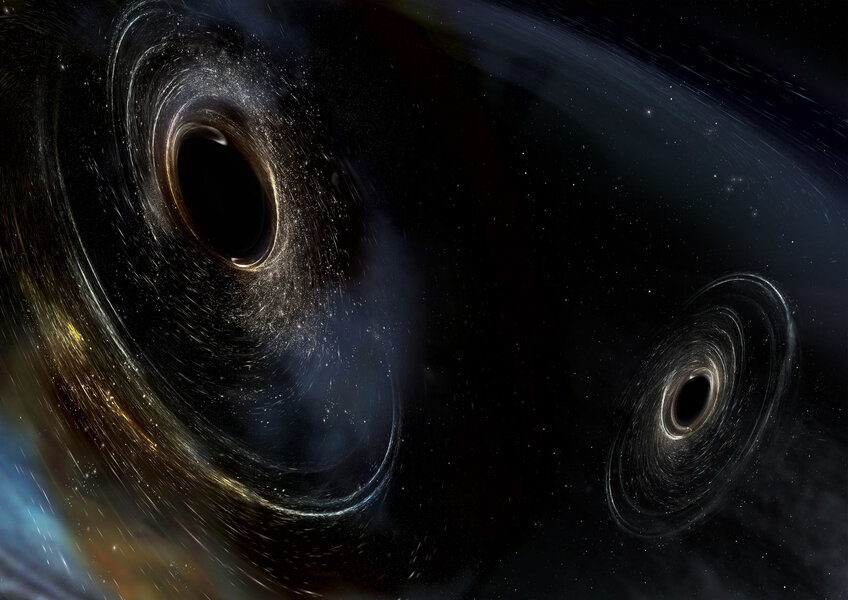Create a free profile to get unlimited access to exclusive videos, sweepstakes, and more!
The biggest black hole merger ever detected rocked the Universe and left behind a mystery

Seven billion years ago* — give or take — a pair of black holes approached their mutual destruction.
They'd been circling each other for a long, long time, but that was about to end. Gradually spiraling closer together over eons, the process accelerated until they whipped around each other at near the speed of light. Then, in less than 100 milliseconds, they approached, distorted, reached out to each other… and merged.
This was no ordinary event. These were hefty black holes, dozens of times the mass of ordinary stars. When they merged to form an even more massive black hole, they let out a positively colossal blast of energy in the form of gravitational waves that literally shook the fabric of spacetime. The waves of energy expanded outward, dissipating with distance.
Then, on 21 May 2019, those waves passed through our planet. Did you feel it? Probably not; the expansion and contraction of space would've stretched you less than a millionth of the diameter of a proton.
But that was enough for the gravitational wave detectors at LIGO to observe this event, dubbed GW 190521. When astronomers looked at the data, they were in for a surprise: This was by far the biggest black hole binary merger ever seen. One of them was 66 times the mass of the Sun, the other 85. Huge.
And this is where things get interesting indeed. When things settled down, the newly born black hole resulting from the merger had a mass of 142 times the Sun, putting it at the lower end of but squarely inside the range of intermediate mass black holes. And none of those has ever been conclusively seen before.
We know for sure about two different populations of black holes. The first are stellar mass black holes, somewhere between 5 to 60 times the mass of the Sun, and are formed when massive stars explode. Another kind are supermassive black holes, from 100,000 up to several billion times the Sun's mass. We're not sure how those form, but the center of every big galaxy sports one, including ours.
Intermediate mass black holes (or IMBHs) would be in the gap between those two populations, and while theorized have never been positively IDed. We've seen lots of candidates, including in distant galaxies, and maybe even in globular clusters, enormous collections of thousands or millions of stars. The idea there is that an IMBH is created stepwise; by the merging of smaller black holes. Globulars are crowded environments, so merging black holes may be relatively common.
GW 190521 may be the best evidence yet of the existence of an IMBH, which is extremely cool. It's seven billion light years away, but still.
In fact when I saw the masses of the two black holes that ate each other I was intrigued. 85 solar masses is bigger than any black hole we expect to get from a single supernova. When a very massive star explodes, the core collapses to form a black hole. Cores from about 32 to 65 times the Sun's mass (which is huge) are unstable, creating huge pulsations in the star which then explodes, leaving behind a black hole less than 64 times the Sun's mass.
Stars with cores from 65 up to roughly 135 times the Sun's mass (and these are absolute beasts; very few exist) undergo what's called pair production instability, where energies in the core are so high that gamma rays (very high energy photons of light) spontaneously split into electrons and positrons. This robs the core of energy it needs to support itself, and the results can be… catastrophic. The star can either have a cosmic paroxysm, or it can explode. The core itself detonates as well, leaving behind no black hole at all.
Stars more massive than that should leave behind black holes in the IMBH range, more than 100 times the Sun's mass… but stars like that are incredibly rare.
So a black hole with 85 solar masses is weird. The only way we know to create one is if two lower mass black holes merged to form it. Even that's not easy; the two that merged would've been pretty hefty as well. I'll note that the even lower mass black hole component of GW 190521 was still very massive, more than most of the final black holes seen so far that have merged! So this system really was a heavyweight.
Here's a video synopsis:
Now, here's a fun fact that will crush your soul and set your brain ablaze. Keen-eyed readers will note that the sum of the masses of the two black holes (85 + 66) is more than the mass of the resulting IMBH (142). What happened to those missing 8 or 9 solar masses?
Those were converted into the energy of gravitational waves, the ripples in spacetime detected by LIGO-Virgo. The conversion uses the formula E= mc2, and if you do the math, you find that the energy emitted by the merger is equal to ten thousand times the total energy the Sun emits over its entire lifetime. That works out to about a hundred trillion years' worth.
Oh, as a reminder, the black hole merger emitted this same amount of energy in one-tenth of second.
There is so much we can learn from this merger, so many questions to be answered. Did this really make an IMBH? How did the two merging black holes get so big in the first place? How often does something like this happen?
But rattling around in my own head is this question: How can the Universe casually toss around mind- (and honestly body-) vaporizing energy like this and yet we didn't even detect it until just a few years ago?
It always makes me wonder: What other enormous things are we missing?
*Correction (2 Sep. 2020 at 16:30 UTC): I originally wrote that the distance was about 5 billion light years to this event, but in reality it took seven billion years for the waves to reach us.




























